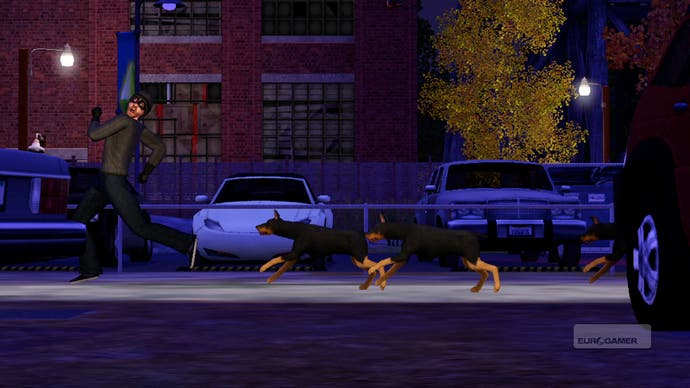The Sims 3 Pets
Animal magnetism.
Pets are also vital for sniffing out clues in the new 'Mysteries' feature. These short narrative diversions are accessed from a mission-style menu, and can be followed throughout the game, picking up the trail to buried treasure or other revelations whenever you fancy.
Those playing on Xbox 360 get an even more interesting exclusive feature: Kinect support. Upon first seeing the Kinect sensor sitting beneath our demo screen, I'll admit that I flinched in anticipation of the horrors ahead. Trying to rotate the screen with hand gestures, fingers fluttering in mid-air as you try to place a wardrobe with some semblance of precision. Motion control and The Sims just didn't seem to go together. Thankfully, that's also the opinion at the studio, and that's why The Sims 3 Pets uses Kinect for its voice recognition, not its camera.
Initially, it feels more than a little gimmicky. In the pet creation screen, you can simply say the name of the breed you want to be taken directly to it. Cute, but hardly revolutionary, and sitting in the living room shouting "Dachsund!" at the TV doesn't seem like much of a brave new world.
In game proper, voice control makes a lot more sense - and subtly revolutionises gameplay mechanisms that have endured since the first Sims back in 2000. Switching between characters, regardless of where they are on the map, is a question of asking for "Sim 1" or "Sim 2", for example. Pets, of course, can be told to "sit' or "stay". But that's obvious, entry-level stuff.
If a Sim is too busy yakking with a neighbour when you want them to be improving one of their skills, you can literally tell them to "stop that". When those status bars begin to deplete, you can perk things with a simple "go to sleep" or "for God's sake, just have a poo". OK, that last one doesn't quite work, but the principle is impressive even if the syntax required is simple by necessity.

The commands also intersect with the Sims' own AI, so they'll take their environment into account. Rather than dictating their every move, you're offering suggestions that the Sim will then act upon. "Have fun" makes your Sim find something to amuse themselves based on what's nearby and what they like to do. "Eat something" sends them to the kitchen, or a nearby eatery, to satisfy their hunger in whatever manner they choose. Conversations can be steered with "be funny", "be friendly" or "be mean".
We're so used to pressing buttons, moving sticks and selecting icons that it almost feels like cheating to simply be able to tell characters what you want them to do. Yet it's also enormously liberating, especially as it sweeps away a huge part of what we presume a game must be.
Later, playing the game on a different demo pod with a normal controller, I'm already missing the simplicity. Such vocal short cuts clearly won't work in most games, but for something like The Sims, where the pleasure is in the payoff rather than the actions themselves, it feels a lot like a stroke of genius - cutting through the icons and menus and just letting you interact in the most clutter-free way possible.
Even though Pets stands alone as a console release, it's still very much part of the Sims 3 lineage and it's rare to find such potentially sweeping changes rolled out in what is, essentially, a spin-off. In terms of pure gameplay, it's shaping up to be another endearing invitation to Simville. In terms of technology and design, it may end up being a lot more influential than expected.
